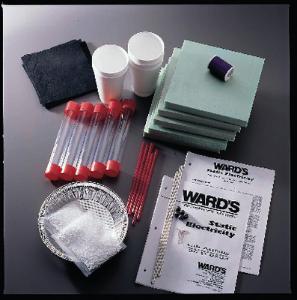Shocking Static Electricity Facts; Plus a free student handout from AccessScience
Spark students’ curiosity about the basics of electric charges. Inspire hands-on educational activities that develop critical thinking skills that students can do at home or in the classroom.
Fill form to unlock content
Error - something went wrong!
Get Your Free Article with Follow-up Questions for Students
You're all set!
EnjoyAccess to this content is available to Ward's World readers for free from McGraw Hill's AccessScience, an award-winning, digital STEM resource containing exclusive articles written by expert scientists and engineers; biographies of well-known scientific figures; science news, videos, and animations; and much, much more.
Instructors can use AccessScience to guide students on their research project journeys, to help students understand scientific concepts, to support distance learning efforts, in flipped classroom approaches, and in countless other ways.
Ward’s World and AccessScience have partnered to offer educators a no-obligation, free trial subscription to AccessScience. Request your free trial today to discover how valuable AccessScience can be for you and your students! Get your free trial now.
Middle to High School
“Opposites attract!” according to Paula Abdul’s hit song. Your students can discover scientific proof of that when they study the properties of electricity. A positive charge attracts a negative charge while two negative charges are repelled by each other. “It ain't fiction, just a natural fact, opposites attract” if you want to sing along.
Static electricity is the perfect topic to spark students’ curiosity about the basics of electric charges. It can inspire hands-on educational activities that develop critical thinking skills that students can do at home or in the classroom.
Little known facts about static electricity
Sure, we all get a chuckle from zapping someone with an electric charge built up from rubbing our feet along the carpet. But, it’s even more fun to learn the little known facts about static electricity like these:
- Lightning is just one huge, powerful burst of static electricity in the sky. It’s caused by a buildup of static electricity inside a storm cloud. Tiny water molecules called hydrometeors move around inside the cloud. When the hydrometeors collide and bump into each other, they create a static electric charge. According to the National Weather Service, temperatures in a lightning bolt can reach 50,000°F (that’s five times hotter than the surface of the sun)!
- We’ve all heard of the Dust Bowl of the 1930s. Did you know those dust storms could generate static electricity so powerful it knocked people off their feet? So much electricity built up between the ground and the thick airborne dust that sometimes, electric blue flames jumped along barbed-wire fences.1 Static in the atmosphere shorted out car batteries and radios. People dragged chains behind their cars and trucks to help ground their vehicles.1
- If you love your electronic devices, beware of electrostatic events! According to the Electrostatic Discharge Association, an electronic device may no longer function if it’s exposed to an electrostatic discharge event (an ESD).2 You may not give a second thought about shuffling around the house in a comfy pair of fluffy socks. As your socks rub across the carpet, electrons jump from the carpet onto you. If enough electrons buildup, they’ll be ready to jump to the next object you touch that has fewer electrons, like a doorknob or your cell phone! Zing! The charge could cause a metal melt, junction breakdown, or oxide failure. That could permanently damage the device’s circuitry causing it to stop functioning totally or at least partially. For example, if your cell phone keypad suddenly doesn’t work, it’s likely the result of electrostatic discharge.2 Similarly, if a USB or Ethernet port isn’t working, it’s probably the result of the same phenomenon. Triboelectric charging, the most common method of charging, explains the science behind the dreaded ESD. Also known as charging by friction.
Download McGraw Hill's AccessScience article on Static Electricity above to share with your students; it has comprehensive facts to support or recharge your lesson plans. It's a valuable resource covering an electrifying topic.
References: 1. Vintage News, Feb. 2019. Crazy Images and Facts about the Great Depression ‘Dust Bowl.’ 2. Electronic Design, May 02, 2014, Phillip Havens and Chad Marak, ESD: A Smartphone’s Worst Enemy
Recommended products
[StartProductBlock]

WWard's® Static Electricity Lab Activity
Shows the basis for charge separation, charge storage, charge polarity, conductors, and insulators. Uses simple materials that work even in damp weather.
[EndProductBlock]
[StartProductBlock]
Hand-Cranked Van de Graaff Generator
The Hand-Cranked Van de Graaff Generator demonstrates the conversion of mechanical energy into electrical energy by generating a static charge. The generator uses human power instead of electricity. Students see how generating a static charge converts mechanical energy into electrical energy.
[EndProductBlock]
[StartProductBlock]

Friction Pad
Excellent pads for friction rod experiments
[EndProductBlock]
